|
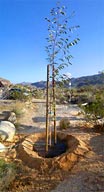
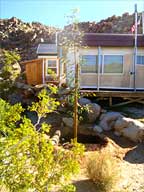 In 2009 we installed a 2600 gallon water tank up in the hill above us with PVC pipe buried up and down the hill and copper pipe throughout and around the trailer and outdoor shower. This enabled us to make full use of such amenities as a kitchen sink, a shower and a clothes washer.
In 2009 we installed a 2600 gallon water tank up in the hill above us with PVC pipe buried up and down the hill and copper pipe throughout and around the trailer and outdoor shower. This enabled us to make full use of such amenities as a kitchen sink, a shower and a clothes washer.
It also allowed me to realize a 40 year dream, that of planting a tree on my high-desert land that would still be alive after a seven month absence, which is another story; this one is about watering that tree.
I planted it in mid April even though I knew I would be leaving early May for the summer. I needed to work out a plan for watering it while I was away. My neighbors had said, "Don't worry. We will take care of it", but I wanted to set up a self-sustaining system; one that would take care of itself, with my neighbors as backup.
I went looking around, online and in the local shops. This had been in the back of my mind for some time, perhaps years, as I thought about how our home could manage itself while we were away. The solar system provided the power, already keeping the fridge cold and the timed toilet fan and heater composting. Now it would also activate an irrigation system. It had to be simple and reliable. Though I more or less wandered vaguely through the next few weeks, in the end it appears as though I made or lucked into the right decisions - it works.
Keep in mind that I did all this knowing that friends had my back. Though I had willingly done likewise in return for these neighbors, though not for this reason; I just like being a good neighbor - and too I liked sitting by their fish pond when they were away and strolling through their Garden of Eden. However I also knew I could call on other neighbors in a pinch. So I took the chance and planted a good sturdy draught resistant
Red River Eucalyptus.
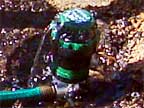
I had a long garden hose I had bought in 2001, but never used (try drinking water that has been sitting in a hot hose - tastes like plastic; yuk!). At Home Depot I found a nice simple
Orbit H2O-6 sprinkler on a spike, simple in that it does not depend on a Rube Goldberg mechanism to function. It is simply a round plastic rotating container with holes around the top below a cap that can be dialed to different spray/mist settings. Of course, I did not need to spray a lawn; instead I needed to flood a tree. I figured I could bounce the spray back with logs and rocks, but it turned out to be perfect for my purpose. Setting the dial half way between its markings would cause it to gurgle - perfect!
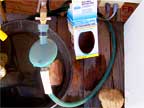
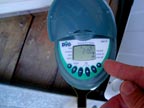 I also bought a
DIG Automatic Timer 9001DB for the other end of the hose, which attaches directly to the hose faucet. Later I added a Y-valve so that the faucet could still be used for other purposes. This is a battery operated timer with various settings for various plans. I experimented with a variety of configurations but ended up with setting it to kick on every Wednesday and Saturday morning at 7:00 AM, run for an hour to flood the tree and then shut off. Perfect. It also includes a manual override button so that it can be turned on or off at any time. This is useful while we are there because we flood the tree with enough grey water to keep it healthy.
I also bought a
DIG Automatic Timer 9001DB for the other end of the hose, which attaches directly to the hose faucet. Later I added a Y-valve so that the faucet could still be used for other purposes. This is a battery operated timer with various settings for various plans. I experimented with a variety of configurations but ended up with setting it to kick on every Wednesday and Saturday morning at 7:00 AM, run for an hour to flood the tree and then shut off. Perfect. It also includes a manual override button so that it can be turned on or off at any time. This is useful while we are there because we flood the tree with enough grey water to keep it healthy.
During that experimentation, I tried the settings that activate the sprinkler multiple times in the same day. I did not need that, but I could not figure out how to turn those settings off. I went to
the DIG website and asked this: "How do you turn OFF the START II and START III settings. I only want it flooding the tree once per day.". Four hours later, they replied with "Van: Push the mode button and bring up the start time that you want to delete. Then push the minus button until the word OFF appears.". That did it.
My next concern was making sure there would always be water available. What happens when the tank empties? Asking my friends to climb the hill and bang on the side of the tank on a regular basis seemed a bit much, even though I found myself doing this a few times a day every day. The big unknown for me was how long 2600 gallons would last. While I was there, I did climb a step ladder a number of times, remove the lid and poke an 8 foot ruler down through the water.
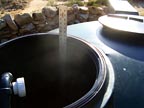
Measuring the water level
|
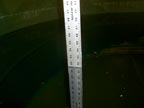
51.5" on April 26
|
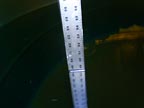
48.5" on May 3, 1 week later
|
From these measurements, I ran calculations and determined that it should last into August or September. Wrong! It ran out in June. Without the ruler, you can't really tell anything from above; all you see is dark water, and when it drops below the outlet pipe, there is still 6" of useless water below that. So the only real way to gauge the water level is to dip a ruler or bang on the side, unless ...
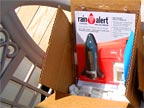

I figured that there had to be some kind of sensor that could measure this for me, and so I did some research online. I found one and I ordered it. It is a
Rain Alert Ultrasonic Tank Level Monitor. It comes with 2 main parts: a transmitter and a receiver. The battery powered (replace after 10 years) transmitter attaches to the top of a vented tank up to 150 feet away. The receiver plugs into any outlet and shows a 10 bar scale similar to that of a cell phone, but large enough to be read at maybe 10 or 15 feet. It refreshes its reading hourly.
Initially, the receiver has to be told how deep the tank is, up to almost 10' max, and the two devices have to be mated (touching each other) when the receiver is first plugged in so that it will know what frequency to look for.
Installing the sonic transmitter was no big thing. I used a 7/8" flat blade bit to cut the hole near the center of the tank top. No debris fell through; instead a long twisted ribbon of green plastic pealed off. I plugged the transmitter into the hole and tightened down the 2 screws provided.
Line-of-sight between the two is not required. I think that the 433 mHz FM signal would just bounce or flow around things haphazardly until the receiver grabs it. The further away you get, the less likely that becomes, until you reach the suggested max of 150 feet at which point I assume the signal becomes too weak and at which point line-of-sight would be required to grab the weak signal. A similar RF technology is used to control TV/sound system line-of-sight IR remote controls from other rooms. In other words, the wireless device in your mobile hand controls the stationary remote that controls the stereo. It does this by replacing a battery in the remote with a battery-transmitter similar I think to the one inside our sonic transmitter.
I did in fact experiment with different positions and settings, which seemed to make no difference, but it took me awhile to realize that it could take up to an hour for each change to register. So if you move the receiver to a new location, it will continue to display the reading for the previous location until the sonic transmitter sends a new signal.
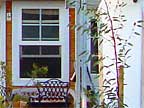 I finally selected a location that is convenient to a person standing at the tree, so that when my neighbor occasionally wanders over on a Wednesday or Saturday morning to see if the ground around the tree is wet, he or she can also glance up at the receiver to see if the tank is low on water. That position puts a full sized utility house and a few boulders between the two devices. It did not seem to mind.
I finally selected a location that is convenient to a person standing at the tree, so that when my neighbor occasionally wanders over on a Wednesday or Saturday morning to see if the ground around the tree is wet, he or she can also glance up at the receiver to see if the tank is low on water. That position puts a full sized utility house and a few boulders between the two devices. It did not seem to mind.
I set all this up on May 2, and I departed for the east coast on May 6, so I did not really have enough time to get a feel for how it was working. It showed 5 bars on the 2nd and went to 4 bars on the 5th. On that day, this neighbor dropped by so that I could show her how the whole setup worked. It was at that time that the screen suddenly blanked out. I had not seen this before. She indicated that electronic things do that around her all the time. Anyhow, the next morning as I prepared to pull out, I was able to yell over to her that it was showing 4 bars again. Note to self: don't let her anywhere near my computer.
Exactly one month later on Saturday, June 5th, I received emails and phone calls from her saying that it was down to 1 bar, and that Tom had climbed the hill and banged on the tank confirming that it was almost empty. I immediately emailed UKAL Water for a quote and after his reply the next day I sent him a check for $110 through my ING bank account online, estimated to arrive on the 11th. On Wednesday, the 9th, this neighbor confirmed that the ground was wet, and that she would be going away for a couple of weeks. I do not know exactly when the tank was filled. On the 24th, UKAL replied that it had been filled, but he did not say when. ING showed that the check was not cashed until the 28th.
On Saturday, June 26, she announced that "THERE ARE EIGHT BARS AND YOUR SWEET TREE WAS WELL WATERED THIS MORNING". Whew!
When I set the receiver in the beginning, I set it to read empty while there would still be some spare water in the tank, that is I set it to 73" even though the tank is actually 84" deep. I suspect that it kept right on watering on schedule and that the tank was refilled before it ran out.
On the next fill-up, whenever that may be, I will know how long a tank of water lasts. Then I can record that schedule in my Outlook calendar and know when to contact UKAL down the line. Also when I return there in the fall, I plan to drop the hose into a series of 5 gallon buckets so that I can know how much one watering actually consumes. However, by then the tree will have developed a pretty good root system and, depending on how the tree is holding up between waterings, I may try to reduce the time from 1 hour to 45 minutes, or less. Actually, while we are there, it will be a question of how many buckets of grey water to give it. I am in fact more concerned about drowning the root system then I am about drying it out; the former can rot a tree to death, whereas the latter will give it a chance to breath and to develop its draught tolerance.
I am quite pleased with how well this system is working and I am thinking about planting another tree or two when I return. Now I want to explore the idea of adding some sort of fail-safe system that could serve as a backup should this system malfunction - perhaps another tank of water and irrigation system that would kick in if a sensor detects that there is no moisture 2 or 3 feet below grade at the tree, or trees. We'll see.
To planting the tree ...
To a more extensive watering system one year later ...
|